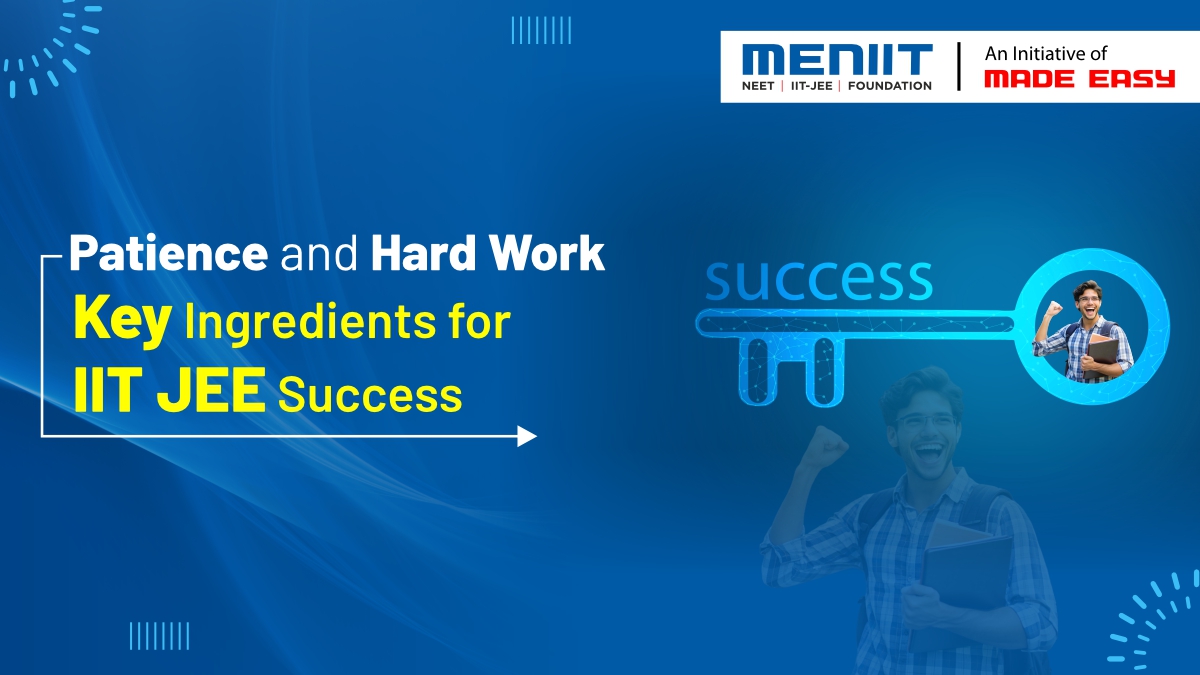Patience and Hard Work: Key Ingredients for IIT JEE Success

IIT-JEE, the gateway to the top technical institute, is one of the toughest and most competitive exams in India. Every year, nearly 10 lakhs of aspirants (combined) appear in both sessions of JEE Main. Those who qualify for JEE Main are eligible to appear in JEE Advanced. The success at IIT-JEE gives a bit of assurance that the career of the aspirant is going to be safe.
The structure of IIT-JEE was not the same as we see it now; earlier in the late 90s or starting in 2000, IIT-JEE was a single-stage examination; there was no JEE Main or JEE Advanced. In the year 2002, AIEEE (All India Engineering Entrance Exam), was introduced for the very first time. In 2003 the structure of IIT-JEE was modified, AIEEE became JEE Main and IIT-JEE became JEE Advanced. In that same year, JEE Main became the screening test for JEE Advanced. Then, further, the structure was modified, and JEE Main became a biannual exam.
In spite of all these modifications, a few things didn’t change, like the enthusiasm of the aspirants, the quality and level of technical institutes accepting JEE Main and JEE Advanced scores, and the requirements of the exam. But what are the requirements of the exam? Either in 1961, when the first IIT-JEE (Command Entry Exam at that time) was held, or in 2025, the requirement for success was the same, i.e., patience and hard work.
In this blog, MENIIT will focus on one of the key factors in the preparation of IIT-JEE: patience and hard work. MENIIT is a new initiative by MADE EASY, an institute for GATE, ESE, and PSUs, for the students preparing for NEET and IIT-JEE.
Let us look through a story how patience and hard-work affect the success percentage in real life.
Once upon a time there was a young boy named Bheem in northern part of ancient India. He had always dreamed of becoming a skilled mace fighter like his grandfather, who was renowned for his speed and strength with the mace. Every morning, before leading his flock to graze on the lush meadows, Bheem would practice mace fight using a mace his grandfather had given him. At first, his technique was not enough. He often kept hurting himself.
One day, as Bheem was practicing near a serene lake, he noticed a wise old man observing him from a distance. Curious, Bheem approached the old man and asked for advice on how to become a skilled mace fighter like his grandfather.
The old man smiled kindly and said, “Patience and hard work, my boy. Mastery in mace fightery, like in any skill, comes from dedication and perseverance.”
Encouraged by the old man’s words, Bheem continued his daily practice with renewed focus. He learned to adjust his strength, control his breathing, and refine his technique. He would spend hours welding his mace, sometimes until the sun set behind the mountains.
Seasons passed, and Bheem’s skill with the mace steadily grew. His began hitting the target with great strength. The villagers started noticing his progress and praised his dedication to mastering the art of mace fighter.
One day, news arrived in the village that a grand mace fightery competition would be held in the neighbouring kingdom. It was a chance for mace fighters from across the land to showcase their talents and compete for honor and rewards. Bheem’s heart swelled with determination — this was his opportunity to prove himself.
With his grandfather’s blessings and the support of the villagers, Bheem travelled to the kingdom to participate in the competition. The competition was fierce, with mace fighters displaying remarkable skill, strength and precision. But Bheem remained calm and focused, drawing upon the years of practice and discipline.
When Bheem’s turn came, he stood tall, took is mace with steady hands, and hit the target with great strength. The crowd erupted into cheers as Bheem’s skill, strength and determination earned him the admiration of all present.
Bheem’s victory in the competition brought pride to his village and fame to his name. He was celebrated not only for his mace fightery progress but also for embodying the virtues of patience and hard work. His journey from a young shepherd dreaming of greatness to a respected mace fighter symbolized the power of dedication and perseverance in achieving one’s goals.
And so, in the tranquil village nestled deep in the mountains, the legend of Bheem, the patient and hardworking mace fighter, continued to inspire generations to pursue their dreams with unwavering determination and steadfast commitment.
The moral of the story is that with constant hard work and patience, one can achieve anything. Imagine what would have been the result if Bheem had stopped practicing after some failure. Would it have been possible for him to win the competition? The answer is no, but it was his hard work, patience, dedication, and practice that made it possible. Similarly, to clear IIT-JEE, one has to maintain patience along with regular hard work. Both hard work and patience are equally important. Hard work without patience won’t give the desired results, and only patience without hard work would also be a waste of time and resources.
If this seems like a fictional story, then here is an example of The Mountain Man: Dashrath Manjhi. He was the man who solely cut the mountain apart. Dashrath Manjhi was from Gaya, Bihar. His wife got injured from falling from a mountain, and later, due to a blockage of the path by the same mountain, he lost his beloved wife. This motivated Dashrath to carve a path through the mountain. After 22 years of continuous hard work and determination, Dashrath carved a 110-meter-long, 9.1-meter-wide road using a hammer and chisel. The outcome of his hard work was that the distance of 55 km was shortened to 15 km.
There are lots of other examples that can show the importance of patience and hard work. History is filled with such examples. Consider a hypothetical situation: if Dashrath Manjhi didn’t have the patience to work for 22 years continuously, would it be possible to cut the mountain without the machinery? If he hadn’t done the hard work for 22 years continuously, would it be possible to carve a road through the mountain? If he can cut the mountain, then IIT-JEE is just an exam. Aspirants just need to keep doing their hard work with patience. The result will be good.
Always remember, success comes to those who patiently work hard.
FAQs:
What is the best way to prepare for IIT JEE?
The best way to prepare for IIT-JEE is to develop command on basic concepts and then solving questions.
What is 75 percent rule in IIT?
The candidates appearing in JEE Mains must have atheist 75 % marks in class 12th.
Can I get IIT with 700 rank in JEE Advanced?
The allotment of college depends upon various factors such as difficulty level of exam, number of aspirants etc. Rank 700 is good and aspirants can secure a seat in IIT.
How can I stay motivated during the preparation process?
The motivation comes from inside, one need to imagine themselves studying in one of the best technical institutes of country.
















